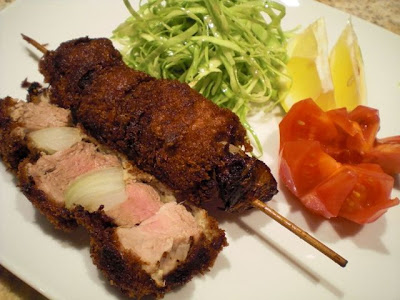Smoked salmon and salmon roe scattered sushi いくらとスモークサーモンちらし寿司
This is our variation on scattered sushi ちらし寿司. "
Sushi" means "vinegared rice". So any dish which uses vinegared rice will fall into the category of "sushi". Scattered sushi is the easiest sushi to make and is a classic home style dish; made by adding any combination of toppings to a bed of sushi rice. Traditional styles use mostly simmered and seasoned vegetables. These could include, among other things,
shiitake mushrooms, carrot, lotus root or "
renkon",
"kanpyo", thinly cut slightly sweet thin omlet ("kinshiran" 金糸卵, meaning golden thread egg), strips of "
nori" sea weed, and
pickled ginger root. You could add any kind of cooked or raw fish (sashimi), shrimp,
uni (sea urchin),
ikura (salmon roe) (if you add all kinds of raw fish, it is called "kaisen chirashi" 海鮮ちらし or "nama chirashi なまちらし).
In Hokkaido, the combination of sea urchin and salmon roe is very popular and called "uni ikura donburi" うにいくらドンブリ. To make this regional specialty, an obscenely large amount of uni and ikura are placed on a bed of sushi rice. My mother introduced my wife to this dish some years ago and it now happens to be my wife's favorite. She enjoyed a wonderful example of this dish in the port city of Otaru near Sapporo on our last visit to Japan. At home, we occasionally make our version of this dish but fresh uni is hard to come by most of the time. Salmon roe is easier to get since it freezes very well. So we make our variation using a combination of good quality cold-smoked salmon and salmon roe. Again, this dish would serve as the last rice dish of the meal in our home Izakaya.
1.
Cooking sushi rice: Start with a good short grain Japanese rice. We use "
Tamaki" rice from California which is "okabo" or non-paddy rice but it is not bad. You could get real "paddy" rice from California as well. Instead of using just plain water, the rice could be cooked with a small piece of kelp and small amount of sake added to the water. Make the rice with slightly less water than would be used to make regular rice. This is so that the rice will be slightly dryer than usual and will absorb enough sushi vinegar. We mostly use an electric rice cooker (my wife is actually in charge of cooking rice--having been coached in what constitutes good rice by my mother in the early days of our marriage). I acquired a special
"Donabe" rice cooker recently and the
"donabe" rice cooker does make slightly better rice. Wash the rice and let it soak in the water for 30 minutes or more before cooking it. Then, let it stand for 15 minutes after it is finished cooking.

2.
Preparing sushi rice: As you can see in this picture, I use a wooden tub (寿司桶) and paddle (へら) but, of course, a shallow bowl and spoon will also work. You could make your own sushi vinegar or use a commercial bottled one. You could get a
more precise recipe for sushi vinegar and how to make sushi rice elsewhere. The amount of sugar and salt in sushi vinegar is a personal preference, some old traditional edomae 江戸前 (Tokyo style) sushi restaurants even omit the sugar. Most of the time, I am too lazy to make my own sushi vinegar so I use a commercial bottled variety. I microwave the sushi vinegar to make it warm before adding it to the rice. Sometimes, however, I even skip this step. The amount of sushi vinegar to rice is another question. I usually put as much as I can without making the rice too wet (warm sushi vinegar appears to be absorbed more). We like a rather strong vinegar taste in our sushi rice. Traditionally, while you are mixing the sushi rice, you fan the rice. My wife helps me by fanning the sushi rice using a Japanese "
uchiwa" 団扇. The exact reasons for this process is not really clear but maybe it makes the additional moisture evaporate. The end result is that the rice grains are shinier than they would be otherwise. I cover the tub with wet tea towel and let it stand for few minutes before putting the dish together. My wife is more of a rice connoisseur than I am and she often complains about the poor quality of sushi rice at near-by sushi bars, which is unfortunately often the case.
3. To make the thin egg omelet ("Kinshiran" 金糸卵): For one large egg, I put 1-2 tsp of sugar and pinch of salt and mix. I often add a small amount (1 tbs) of "dashi" broth but this is optional. Use a Japanese style rectangular frying pan or use a 8 inch regular non-stick frying pan with a small amount of butter or oil. You need to make this omelet very thin. The secret is to pour the egg mixture after the pan is hot (on medium flame) and once the bottom is set, to reduce flame very low and put the lid on. You do not want to brown it. It may take more than 5-7 minutes before the egg is cooked. Take it out of the pan onto a cutting board. Cut into 4 elongated pieces, stack them and julienne thinly.
4. Put the sushi rice in the bottom of the bowl or plate and top it with bite sized pieces of smoked salmon, salmon roe, thinly sliced salted and vinegared cucumber (excess moisture squeezed out), "kinshiran" or golden egg threads, shredded "nori" seaweed, finely chopped perilla and/or scallion. You can make any variation as you like depending on the ingredients available.





































